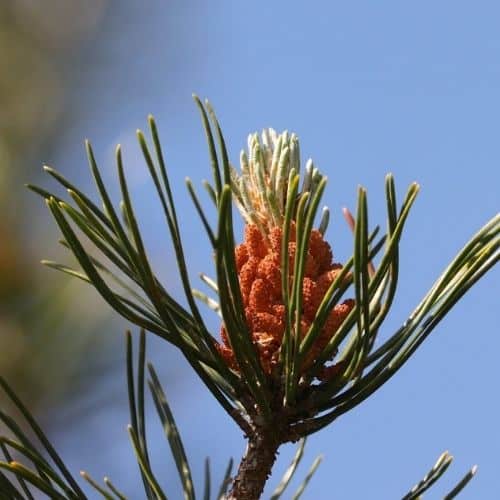
Has it ever happened to you that you have moved into a new house with a barren backyard? Chances are that you must have thought about growing a few trees there to make it look pretty. As you probably know, the process is not quick and easy. You need to know which trees will grow fast and which ones will grow slow. Even if you choose a fast-growing tree it can take a long time for them to become decent in size. Let’s take a look at what you can expect from different varieties of trees.
People say that planting a small sapling in a place of cutting down a huge tree is just not the same. As you must have guessed by now, trees don’t grow overnight. They don’t even grow within a few months. In reality.
So how long does it take to for a tree to grow? It will take a very long time for a tree to become full size, but the average time it takes to grow a 20ft tall tree, is 7 years. However, for some trees, it will take much longer.
FASTEST GROWING TREES
The growth rate of trees varies a lot. Some take hundreds of years to fully mature while some go through their life cycle in just 50 years. Depending on their life cycle their growth rate also differs a lot. Some trees can grow up to 8 feet per year while some will only add a couple of feet to their height.
In recent times, people have started preferring to grow fast-growing trees. There are a few reasons for this – one, they want to see faster results. If you are growing trees in your backyard, you want to see them grow as soon as possible.
Secondly, they don’t want trees to get too big. A lot of the slow-growing trees also tend to get bigger over time and they can completely overshadow the house if you don’t pay attention to pruning them.
Let’s take a look at some of the species which are considered to be fast growers all over the world. their growth rates differ a little bit, but most of them can grow anywhere between 5 to 8 feet per year. Depending on the area you live in, with some effort you can further increase their growth rate if you’d like.
HYBRID POPLAR
This tree has an impressive growth rate of 5-8 feet per annum. These trees are usually used as an energy conservation method. They are also preferred for firewood as they can be replenished very quickly.
More on Poplar as firewood in this post.
WEEPING WILLOW
I am pretty sure you have heard this name through children’s stories. Well, besides that, one advantage of this tree is its growth rate. They can add up to 8 feet per year.
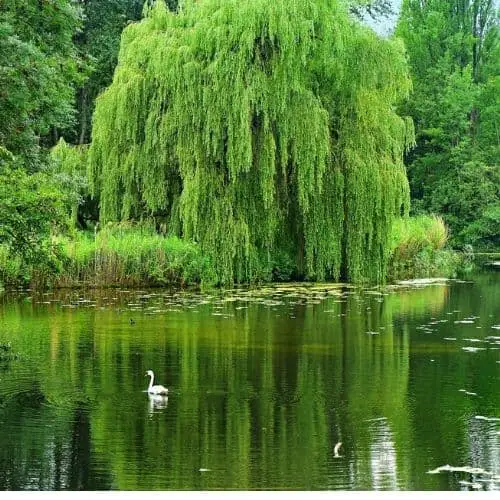
QUAKING ASPEN
Chances are that you must have noticed this tree during the fall season because of its color. They are very closely related to the Hybrid Poplar. They can grow anywhere from 3 to 4 feet per year.
OCTOBER GLORY RED MAPLE
This is one of the most distinctive trees on this list, they are hard to miss due to their intense red color during the fall. They have been modified over the years with other relatives to grow faster so they can also add about 4-5 feet per year.
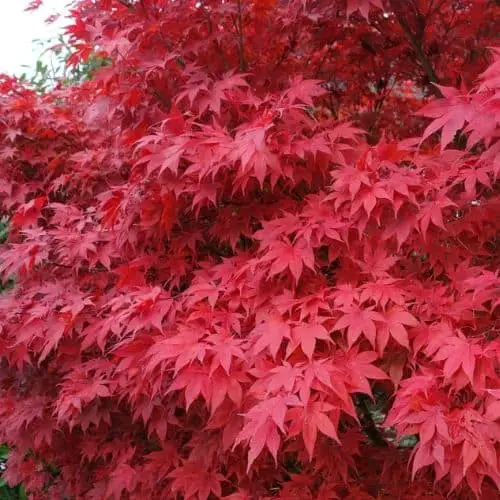
DAWN REDWOOD
These are some of the most popular choices for private forests. With good care, they have recorded a growth of 120 feet in just 30 years. That is a lot when compared to other trees like pine and fir or even oak.
LEYLAND CYPRESS
They are the go-to choice for gardens or for home landscaping. This is because of their column-like shape and decent growth rate. They can add up to 4-5 feet per year.
Trees that grow more than 3 ft per year are considered to be fast growing trees.
SLOWEST GROWING TREES
If you think that the last few growth rates were slow, you have no idea what you are in for. Some trees have a life cycle of more than 1,000 years. These trees take hundreds of years to mature and fully grow and some of these trees grow less than 1 foot per year. Interestingly, trees that have a slow rate of growth tend to stay alive for longer. They can also face harsher conditions over time.
MAGNOLIA GRANDIFLORA
These trees are known for the white flowers that they bloom. But their growth rate is only about 1 foot per year. They can grow to about 80 feet in height on average. Some areas have recorded a growth of up to 120 feet. If you think about it, it should have taken this tree about 120 minimum to reach that level. A lot of trees also slow down as they grow. So, it is possible that they might not even grow at 1 foot per year later on.
WHITE CEDAR
Interestingly one of the slowest growing trees in the world is White cedar. I am not sure about this statistic but apparently one of the oldest White Cedar, after 120 years the tree has only grown about 4 feet. But in general, white cedar is considered to be a slow-growing tree. They add about 1-2 feet per year to their height.
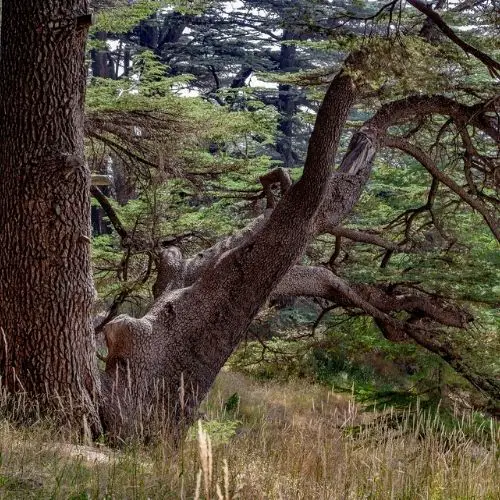
WISTERIA FLORIBUNDA
This tree is native to Japan. They have come to the US only in the past 200 years or so. they only reach about 30 feet in height but may take about 20 years to reach there.
HAWTHRON
This species is considered to be one of the slowest on the planet. You won’t believe it but they are hardly able to grow at feet per year. Well that’s slow, don’t you think?
Looking at 1 ft per year then 6-7 ft per year does not seem so slow after all does it?
Within this low-growing category we also have Maple, Hackberry, Norway Maple, White Fir, Honeylocust among many others. I could keep writing for hours if i was to list all of them.
There are a lot of other species that are considered to be slow growers. Most of them are part of large forest systems. This is because it is not really reasonable for regular people to grow these species. Though there is a lot of research that shows that slow growers are better at filtering CO2 and can survive for longer periods of time.
Recommended reading:
AVERAGE TREE GROWTH IN A YEAR
As I have discussed before, the rate of growth varies a lot. It depends on the species of the tree and the conditions it has been subjected to. For example, the kind of soil, fertilizer, the light will play a large role in determining the rate of growth.
Usually, a species is divided into three categories. Fast grower, medium grower, and slow growers. If a tree is increasing in height by more than 3 feet per year, it is known as a fast grower. Similarly, if it is between 1 and 3 feet per year then it is medium. While if the tree grows less than 1 foot per year it is considered to be a slow grower.
Usually, trees grow naturally in any of the 3 categories. But with proper care, it is possible that a slow-growing tree jumps into a medium category.
Take for example trees growing near the equator. They tend to naturally grow faster as compared to any of the temperate regions. This is clearly because of more consistent sunlight which also shines for a longer time. Similarly, a coniferous tree will die if it starts to sown near the equator.
You have to make sure that you are providing the specific nutrients and conditions for that specific tree to make sure it grows faster.
Trees that grow less than 1 ft per year are considered to be slow-growing trees, anything between 1-3 ft per year is categorized as medium-growth rate trees. Trees that grown more than 3 ft per year are considered as fast growing trees.
HOW SOIL AFFECTS THE GROWTH
It will come as no shock that the type of soil being used heavily influence the growth rate. Let me explain – the roots of the tree will absorb water, some oxygen, CO2, Nitrogen, Phosphorus, and Urea from the soil. It then travels through the entire tree feeding each and every part of it.
A soil rich in these nutrients will obviously lead to a healthier tree. But not only this, but it also affects the growth rate. The more food and nutrients a tree has, the faster it can grow.
There are some things that you can do with the soil to enhance the growth. Not all of them are good. For example, some people recommend adding the ash around your tree. Although it will increase the growth rate, it will only happen for a short amount of time. What actually happens is that ash destroys the nitrogen content of the soil. Nitrogen if you don’t know is probably the most essential nutrient a tree needs.
Once nitrogen is depleted, some of the other nutrients also get washed off by rain and water. Therefore, in the long run, adding ash to the soil is not a good idea.
One thing which a lot of researchers recommend is to add humus to the soil. Research conducted by Barrington Moore on different plant species was that adding humus always resulted in boosted growth.
One of the reasons why sand is not suitable for the growth rate of trees is the lack of nitrogen. But even when testing the hummus test on sandy soil, it was noticed that adding humus increased the growth rate.
Another factor that affects the growth rate is the amount of oxygen in the soil. You need to provide some aeration for the roots to be able to absorb oxygen. When we talk about nutrients, notice how trees in forests grow to be huge and healthy. The reason for this is the availability of a large variety of nutrients.
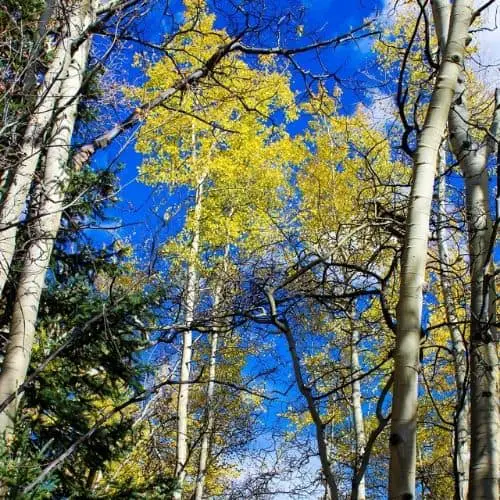
Forests have a large variety of animals, trees, and insects. They all work with one another and keep rejuvenating the soil. This is what’s lacking in a lot of people’s backyards. The solution to this problem is to provide the soil with missing nutrients through fertilizers and mulch.
Different soil types
Soil types can be largely divided into the following categories. Usually, you will have to mix and match different soil types to create the ideal composition.
Sandy: think of a desert, the particles are pretty loose. This has one advantage of having plenty of air, but on the other hand, it cannot hold any moisture. This makes it difficult for roots to access water for growth.
Silt: it has a very smooth texture and is made up of fine particles. It can hold water and nutrients pretty well. But it might create problems for trees that require higher amounts of oxygen.
Clay: you know what clay is, it is the natural version of slime, what you and your kids probably have played with. If you have ever observed clay, it is very tight. This means that it cannot hold a lot of oxygen in it. Roots have a really hard time getting oxygen there.
Loamy: this is the most suitable soil for a lot of varieties of trees. It holds oxygen pretty well while also holding on to moisture and nutrients. People usually mix and match different types of soil to reach this consistency.
Chalky: it is very difficult to grow plants or trees on this soil. It is that layer of stony soil which lies on top of limestone.
A soil rich in these nutrients will obviously lead to a healthier tree. But not only this, but it also affects the growth rate. The more food and nutrients a tree has, the faster it can grow. The soil where trees will grow the fastest would be loamy soil whereas sandy soil would be the most difficult.
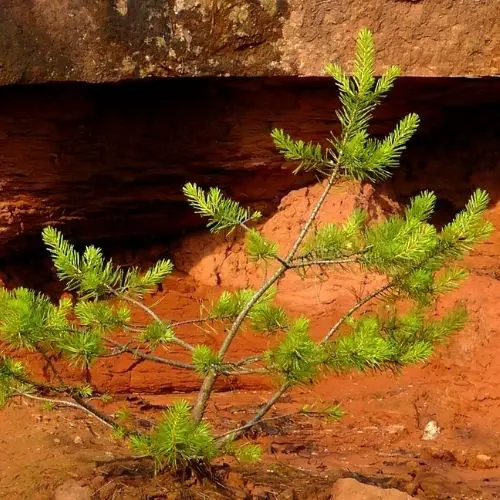
HOW LONG DO TREES TAKE TO FULLY GROW
To answer this question let’s take a brief look at the life cycle of a tree. How it grows from a seed to a fully grown tree and then again becomes part of the soil. If you are growing a tree from a seed of course you will be the one placing it in proper conditions so it can grow. But throughout the ages, different seeds have evolved features that help them reach the perfect spot.
Some seeds are very light so they can use the wind to travel. Some stick to animals while some have very hard coatings as protection. Whatever the mode of transportation is, once they will only start growing once reaching the right place.
The first step is the emergence of the first root. This root will provide extra water and nutrients to the seed. After this step, is the growth of the first shoot. It will slowly push the soil to emerge out of it and start poking its first leaf.
This is the point in its life where it is called a seedling. This is a tree’s most vulnerable age. Any animal might trample it or eat it. Strong rain and wing can uproot it. Any disease can completely kill the tree.
If the seedling has survived all of this, it can go on to become a sapling. Usually, when a tree is about 3feet tall, it is called a sapling. If you see a young tree with smooth usually green trunks, it is a sapling. One of the other characteristics is lack of blooming or fruits.
How much time a tree remains a sapling depends on the species. Fast-growing trees will grow quickly while slow growers won’t. For example, Yews and Oaks spend a lot more time being a sapling than Wild Cherry or Silver Birch.
A tree is known to reach maturity when it starts producing fruits or flowers. This is also known as the productive age of the tree. How much time it takes for a tree to reach this stage and stay here depends on the species of the tree we are talking about.
For example, it will take about 40 years for an English Oak to reach maturity. But this is not its peak productive age, which would take place around 80-120 years. A lot of Oaks can remain productive for around 300 years. They can then stay dormant for another 300 years before starting to decay.
On the other hand, some trees can start decaying by the time an oak reached peak maturity. Take the example of Rowan, it will reach maturity within 15 years. It will start decaying by the time it is 120 years old.
Life spans of some other species are stated below. Note that these are just estimates and average life spans.
| Species | Life Span (Average) in years |
| Redbud | Around 20-30 |
| Bradford Pear | Around 20-30 |
| Mexican Plum | Around 40 |
| Eve’s Necklace | Around 50 |
| Crape myrtle | Around 60 |
| Boxelder | Around 75 |
| Cucumber tree | Around 80 |
| Cedar Elm | More than a 100 |
| Blue Spruce | Around 150 |
| Live Oak | Around 300 |
| Pecan | Around 300 |
| American Elm | Around 300 |
| While Oak | Around 300 (sometimes 600) |
| Eastern Hemlock | About 450 |
The next stage after maturity is called ancient. There is no specific age in which we can call a tree ancient. Trees like Yew reach this stage in thousands of years while Rowan will reach there in a century. Some of the characteristics to look for in an ancient tree are a hollow trunk and small canopy.
After this stage is the final stage, this is the time when the tree starts decaying. It might not produce flowers anymore or fruits but they are still very useful. Insects, birds, fungus thrive within a decaying tree. They contribute to the overall biodiversity of a forest.
Recommended reading:
HOW LONG DOES IT TAKE FOR A TREE TO GROW 10FT, 20FT
As we have already discussed before, the growing rate greatly varies from one plant to another. On average, you are looking at about 5-10 years for trees to reach 20ft in height. Let’s take a look at some of the growing rates of different trees.
- Take the example of a Japanese Cedar, it is a go-to choice for a lot of people for their landscaping needs. They tend to grow up to about 50 feet tall and 10 feet wide. If you buy a 6 feet sapling from a nearby nursery you can expect them to reach about 20 feet in height within 10 years.
- Similarly, if we talk about Tulip Poplar, it also shows an impressive growth rate. They are a great choice for both forest needs and landscaping. This is due to their flowering during spring and amazing colors in fall. A 6ft sapling can grow up to reach about 25ft in height within 10 years.
- Black Gum has great survival traits. They can survive through mild droughts and can even grow in a bit of shade. Even with all of these properties, their growth rate is pretty impressive. They can grow up to be about 18-20 ft tall within 10 years from being a 6feet sapling.
- Other trees like Amur Maple, Japanese Zelkova, Chinese Pistache, Bald Cypress, Redbud, Japanese Pagoda have impressive growth rates. They all grow up to about 20 ft in height within 10 years.
- Leyland Cypress on the other hand is one of the fastest-growing trees out there. If you get them when they are about 2 feet high, they will reach to be 10 feet within 2 years.
HOW LONG DOES IT TAKE FOR A TREE TO GROW BACK AFTER BEING CUT DOWN?
A lot of people are surprised when they get to know that trees can grow back after being cut down. The reality is that not every tree can.
How this system works is that imagine you cut down a tree.
Once you do this, the tree cannot produce any more food through its leaves. Even the roots stop growing once the tree has been cut down. But what a lot of people don’t realize is that roots have some amounts of stored energy. If you cut down a fast-growing tree, the roots can have enough energy to produce another leaf or a branch.
If enough leaves are produced they can start making food again for the tree. These sprouts or leaves usually start to appear around the outer layer of a tree trunk and grow from there.
If you are looking to cut down a tree due to nuisance or safety issues, make sure to use a tree killer. Otherwise, there might be a chance that the tree might grow back. One trick that people use to get rid of trees is to directly kill the roots once they have been cut down.
Some of the examples of trees that don’t grow back after being cut down are Oaks, Maples, Fir, Cedar, Cypress, etc. on the other hand, some of the trees that do grow back are Russian Olives, Cottonwoods, Willow trees, Elms, Tree of heaven, Poplar Trees.
If you are confused about whether your tree will grow back or not, the general rule is: fast-growing trees tend to grow back. Once you have cut down the tree, it can take anywhere from 2-6 weeks for new leaves or branches to start growing. Although it will take years for the tree to reach the same height again.
HOW TO BOOST TREE GROWTH?
To answer this question, we have to go back to the beginning of this article. What things does a tree need to grow? This includes sunlight, water, nutrients, and air. To boost the growth rate of any tree, you have to make sure the tree is getting all of these things. But not only this, you have to make sure the tree is getting the right nutrients.
The first thing you should do is research and ask the local nursery about the specific needs of your tree. Once you have figured it out, the next step is to get your soil tested. You will get to know exactly what is available in your soil and what is missing.
Through this, you can add to the soil exactly what the tree needs. This will also save you some money over the long run. This is because you won’t be adding anything and everything to the soil. Also, make sure that the soil composition is correct. That it is able to hold on to moisture and nutrients. At the same time till the soil to let some air inside it.
When the tree is just a seedling, grow it inside to protect it from the harsh environment. This way you can provide just what the tree needs during its initial growth stages. Once it has turned into a sapling you can take it outside, or even plant it.
- At this stage, put a fence around the small tree so wild animals don’t eat or trample the plant.
- Make sure the site you are placing the tree in has enough sunlight.
- Make sure it is not directly in the path of strong winds. Even water flow during the rainy season can wipe out a young tree.
- If the area you live in goes through dry seasons, make sure the tree is getting adequate water. You can also add some mulch or humus to the soil. As I have discussed above, adding mulch always increased the growth rate.
And that’s it! You have taken care of sunlight, water and nutrients. If you boost the supply of these factors it will automatically boost the tree’s growth.
To boost tree growth you have to make sure that the tree has enough water, light, air and nutrients. You can accomplish most of the necessary aspects it by planting the tree in suitable soil and fertilizing the soil.
FREQUENTLY ASKED QUESTIONS
It is very likely that you will be confused after going through so much information. Don’t worry, I will try to address some of the most common queries that people have about this topic. Hopefully it will address some of your doubts as well.
ARE THERE ANY SPECIFIC NUTRIENTS THAT ARE COMMON TO MOST TREES?
Some of the most common nutrients that almost all trees need is nitrogen and phosphorus. Urea is pretty common as well. Also, mulch and humus are a must for optimum tree growth.
WHAT TO DO IF THE CLIMATE IS DRY MOST OF THE YEAR WHERE I LIVE?
Don’t worry, you don’t have to use a lot of water for the entire area you are growing trees in. These days the best thing to do is to use drip irrigation. Through this, there is a constant supply of water slowly directly near the roots of the tree. This way you end up saving a lot of water.
IS THERE A WAY TO PROTECT THE TREE FROM LANDSLIDES OR FLOODS ON A SLOPE?
I would recommend planting some small shrubs or plants above the tree. These help to bind the soil together. Through this, the soil tends to be less prone to landslides.
SHOULD I STICK TO ONE VARIETY OF TREE FOR MY BACKYARD?
No, I would go for at least 3-4 varieties. You never know what grows the best in your area. This way you are not putting all your eggs in one basket. Different varieties also look better.
CONCLUSION
To sum it all up, it can take a long time for a tree to reach maturity. It can take anywhere from 10 to 100 years for a tree to reach the productivity stage. Remember that trees are divided into fast, medium, and slow growers. Usually, slow growers tend to live the longest as well.
You can boost a tree’s growth rate by providing ample sunlight, water, and nutrients. While selecting a tree, check its growth rate and needs. Not all trees need the same things and some trees might not be suitable for your area.

Hi!
I am the guy behind Theyardable.com. I grew up on a homestead and I am here to share the knowledge I have and things I learn while living in the countryside.
